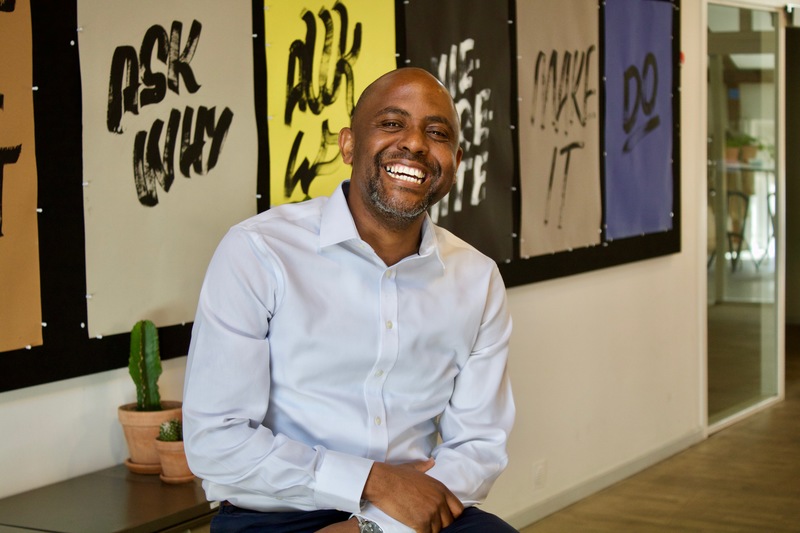
5 Questions: Tendayi Viki on Building Innovation Momentum Without the Struggle
Innovation efforts get stuck long before they scale because innovation isn’t an idea problem. It’s a leadership problem. And one of those problems is that leaders are expected to spark transformation, without rocking the boat.
I’ve spent my career in corporate innovation (and wrote a book about it), so I was thrilled to sit down with Tendayi Viki, author of Pirates in the Navy and one of the most thoughtful voices on corporate innovation.
Our conversation didn’t follow the usual playbook about frameworks and metrics. Instead, it surfaced something deeper: how small wins, earned trust, and emotional intelligence quietly power real change.
If you’re tasked with driving innovation inside a large organization—or supporting the people who are—this conversation will challenge what you think it takes to succeed.
_______________________________________________________________________________________________
Robyn Bolton: You work with a lot of corporate leaders. What’s one piece of conventional wisdom they need to unlearn about innovation?
Tendayi Viki: That you need to start with a big bang. That transformation only works if it launches with maximum support and visibility from day one.
But we don’t think that way about launching new products. We talk about starting with early adopters. Steve Blank even outlines five traits of early evangelists: they know they have the problem, they care about solving it, they’re actively searching for a solution, they’ve tried to fix it themselves, and they have budget. That’s where momentum comes from.
But in corporate settings, I see leaders trying to roll out transformation as if it is a company-wide software update. I once worked with someone in South Africa who was introduced as the new head of innovation at a big all-hands event. He told me later, “I wish I hadn’t started with such a big bang. It created resentment—I hadn’t even built a track record yet.”
Instead of struggling and pushing change on people, I try to help leaders build momentum. Think of it like a flywheel. You start slow, with the right people, at the right points of leverage. You work with early adopter leaders, tell stories about their wins, invite others to join. Soon, you’re not persuading anyone—you’ve got movement.
RB: Have you seen that kind of momentum work in practice?
TV: A few great examples stand out.
Claudia Kotchka at P&G didn’t go around talking about design thinking when she started. She picked a struggling brand and applied the tools there. Once that project succeeded, people paid attention. More leaders asked for help. That success did the selling.
And there’s a story from Samsung that stuck with me. A transformation team was tasked with leading “big innovation,” but they didn’t start by preaching theory. They said, “Let’s help senior leaders solve the problems they’re dealing with right now.” Not future-state stuff—just practical challenges. They built credibility by delivering value, not running roadshows.
If you can’t find early adopters, then take one step back. Solve someone’s actual problem. People are always fans of solving their own problems.
RB: When you think about leaders who are good at building momentum, what qualities or mindsets do they tend to have?
TV: Patience is huge. This stuff takes time. And you have to set expectations with the people who gave you the mandate: “It’s not going to look like much at first—but it’s working.”
And I think you can measure momentum. Not just adoption metrics, but something simpler: how many people are coming to you without you pushing them? That’s real traction. You don’t have to chase them. They’re curious. They’ve seen the early wins.
Another big one is humility. You’ve got to respect the people who resist you. That doesn’t mean agreeing with them, but it means understanding. Maybe they need to see social proof. Maybe they’re waiting for cover from another leader. Maybe they’re not comfortable standing out.
None of that means they’re wrong. It just means they’re human. So work with the confident few first and bring in the rest when they’re ready.
RB: Have you always approached resistance that way?
TV: Oh no—I learned that one the hard way.
Early in my career, I was running a workshop at Pearson. I was beating up on this publishing group about how they’re going to get killed by digital, and they were arguing. It was a really difficult conversation, and I was convinced I was right and they were wrong.
Afterward, one of the leaders pulled me aside and said, “I don’t disagree with what you said. I think you’re right. But I didn’t like how you made us feel.”
And that was the moment. They weren’t resisting because of the content. They were reacting to how I delivered it. I made them feel stupid, even if I didn’t mean to. And their only move was to push back.
It took me years to absorb that lesson. But now I never forget: if people are resisting, check the emotional tone before you check the content.
RB: Last question. What is one thing you’d like to say to corporate leaders trying to drive innovation?
TV: Just chill!
Seriously. There’s so much *efforting* in corporate transformation. All the chasing, tracking, nudging, following up. “Have they responded to the email? Did you call them?” All that pressure to push, to prove.
But it reminds me of this Malcolm Gladwell podcast, Relax and Win, about San Jose State sprinters. Their coach taught them that to run their fastest, they had to stay relaxed. When you tense up, you actually slow down.
Innovation works the same way. Don’t force it. Build momentum. Let it grow. And trust it once it’s moving.
_____________________________________________________________________________________________
The real challenge in corporate innovation isn’t convincing people that change is needed—it’s helping them feel safe enough to join you.
This conversation with Tendayi reminded me that the most effective innovation leaders don’t lead with pressure or pitch decks. They lead with patience, empathy, and small wins that build momentum.



